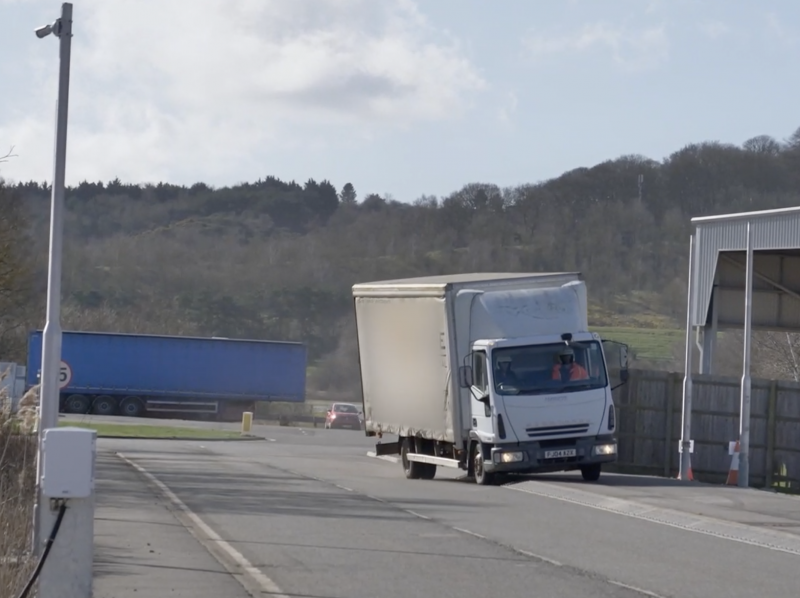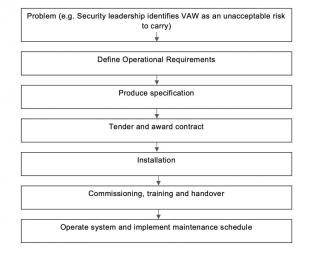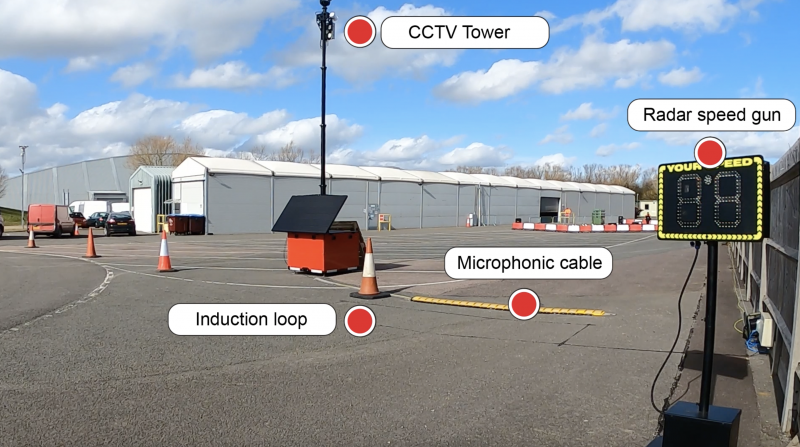Overview
This guidance presents an overview of the principles behind VAW detection, the different technologies available and considerations regarding the environments in which they may operate.
The objective of VAW detection is to significantly improve speed of awareness of an attack and clarity of a situation.
This guidance should be considered in conjunction with NPSA's guidance on Vehicle Borne Threats, Hostile Vehicle Mitigation, Incident Response and Marauding Terrorist Attacks.
An introduction to Vehicle As a Weapon Detection
Increasingly, vehicles are being used as a weapon in order to carry out attacks with hostile intent.
Vehicle as a Weapon (VAW) attacks aim to target and harm people, damage or disrupt infrastructure, or breach a secure perimeter and gain access to the area beyond.
These kinds of attacks are attractive as they are relatively simple to conduct, are of low complexity, require little in the way of skill, and are perceived to be hard to detect in the planning phase.
VAW attacks can take place anywhere a vehicle can access. This could include a pavement alongside a busy high street, a pedestrian only area such as a town centre, an area temporarily closed for a sporting event or festival, or an access point to Critical National Infrastructure (CNI).
Limiting the duration of an attack and consequently its severity, will depend on rapid, reliable and accurate detection along with an appropriate response.

Countering VAW attacks is a subset of Hostile Vehicle Mitigation (HVM). The best practice and standards set out in existing NPSA guidance provides the most effective protection. However, despite best intentions, implementation of HVM best practice may not be possible for the area needing protection from hostile vehicles. Therefore, VAW Detection Systems may be used to supplement areas with existing HVM such as barriers or bollards, or may be used in isolation, either as a temporary or semi-permanent solution.
VAW detection technologies have been developed, which can either function independently or integrate with a wider security system. Without VAW detection, it can be extremely confusing and slow to establish what has happened. The clarity and speed provided by a VAW Detection System is essential to the deciding and implementing of a response.
There are many factors to consider when defining operational requirements and producing a product specification for a VAW Detection System.
These include:
- environmental
- climate
- landscape considerations
- deployment
- integration and maintenance considerations
- adherence to regulations
- response strategy.
A VAW Detection System will raise an alarm if it believes a VAW attack has started. The response to this alarm is critical to limiting the severity of the attack. The response to an alert must be planned, trained and exercised to ensure it is fit for purpose but could range from a localised alarm to contacting security/policing partners or automatic closing a final denial vehicle security barrier system to protect your assets and people.
VAW attacks
A VAW attack involves deliberately driving a vehicle at an individual or into crowds of people to cause harm, deliberately driving a vehicle into infrastructure to damage or disrupt its operation, or breaching a secure perimeter to gain access to the area beyond.
Immediately before (or during) such an attack the driver is unlikely to comply with the rules of the road and therefore may:
- Park illegally;
- Ignore traffic signals;
- Drive at speed;
- Drive on the wrong side of the road;
- Traverse over green spaces such as fields, recreational ground, parks;
- Mount footways;
- Enter pedestrianised zones.
However, it should also be noted that these offences can occur frequently in other situations without terrorist intent. VAW attacks can potentially take place anywhere a vehicle can access. Examples include, but are not limited to:
- A footway such as the pavement alongside a bridge or busy high street.
- A pedestrian only area such as a market place or town centre.
- An area usually open to traffic but temporarily closed for sporting event or seasonal market.
- The entrance to, or perimeter surrounding, CNI.
VAW detection systems
Existing technologies for the detection of illegal parking, ignoring traffic signals, driving at speed and driving on the wrong side of the road are well established. However, these technologies are typically used in the enforcement of traffic violations or on Smart Motorways as opposed to use for VAW detection.
If using these existing technologies for VAW detection it is expected there will be a high frequency of false alarms. This may or may not be acceptable as a HVM scheme depending on the scenario and application and response strategy.
It is possible to develop these systems further to better suit VAW detection, for example an alarm could be raised only if the same vehicle committed multiple violations over a short duration in a high risk area.
Current VAW detection technologies have been developed against a requirement to detect a vehicle with hostile intent as it mounts a footway, enters a pedestrianised zone or crosses a perimeter line. This is fundamentally achieved by detecting a vehicle travelling at speed as the vehicle either crosses a perimeter line or enters (or begins to move within) a defined area.
There are a number of different technologies used for detection which can typically be categorised as either near field or far-field sensors. Near field sensor types used include magneto resistive sensors, pressure sensors, inductive loops, microphonic sensors, reed switches and radar, whilst far-field sensors include radar and video analytics.
The output from a VAW Detection System is an alert of some type. This may be via a software based user interface, or a simple alert output (for example a digital I/O) from a control module. VAW Detection Systems are designed to operate independently, or integrate with existing security systems or a security control room.
The performance of a VAW Detection System is defined by the accuracy and rate of detection, the speed of detection, the rate at which false alarms may occur and any limitations of use due to the detection technology or system employed.
Factors which may affect detection performance include vehicle type, weather conditions, light levels, sensor obscuration or interference, or the quality of installation of the VAW Detection System itself.
These factors may also affect the frequency of false alarms. Other factors which may affect false alarms include pedestrians, bicycles, motorbikes or vehicles travelling in close proximity to the area or perimeter being protected.
It is essential to find a balance between high detection rates and low false alarm rates when commissioning VAW detection technologies.
Figure 1: Possible VaW detection deployment
VAW detection system selection

VAW Detection System selection must be based upon security planning, led by wider security risk assessments, resulting in the design and deployment of risk-based actions and measures.
Before attempting to select a VAW Detection System, Security Owners must establish the system requirements and therefore the operation requirements must first be defined. A recommended process for selecting, installing and commissioning a VAW Detection System is therefore as follows.
There are many factors to consider when defining operational requirements and producing a product specification for a given scenario or application. Some of the key technical considerations are listed below:
- What are the climatic conditions
- Are there local topographical features which may influence or enhance the system?
- Is the requirement to protect an area or a perimeter line?
- How large is the area/perimeter line?
- If the requirement is to protect an area, would protecting the boundary and/or access points meet the operational requirements, or is it necessary to monitor the entire area (or parts thereof) for vehicle movements?
- Is the operational requirement for a permanent (fixed) or temporary (mobile/deployable) solution?
- What existing security system(s) or policies must system be interoperable with?
- Are there existing near-field or far-field sensors in use in the area/perimeter to be protected which could be utilised?
- Is there existing infrastructure such as power and data connectivity for the VAW Detection System?
- What are the acceptable performance levels for detection rate and false alarm rate?
- Should the presence of the system be overt or discreet?
- What is the VAW attack response strategy and does this influence the system specification?
NPSA have developed a VAW Evaluation Programme to assess the performance of these systems. VAW Detection Systems that meet the requirements of the NPSA VAW Detection Standard are listed in the NPSA Catalogue of Security Equipment (CSE).

VAW attack operational response
Limiting the duration of a VAW attack and consequently its severity will not only depend upon on rapid, reliable and accurate detection, but also on the effectiveness of the subsequent response. It is therefore essential that good planning, training, exercising and rehearsing is used to deliver effective reporting and a timely response to a VAW attack.
As is the case for VAW Detection System selection, the response to a VAW attack alert must be based upon security response planning, led by wider security risk assessments, resulting in the design and deployment of risk-based actions and measures.
A Response Plan should set out the end-to-end response to a VAW attack. The response must be rapidly deployable, proportionate, effective and lawful. The need to develop a clear understanding of individual roles and responsibilities is of considerable importance in relation to both the reporting and response to an incident.
When planning the operational response to a VAW attack alert, Security Managers should consider:
For example, this could be integrated into a new or existing Security Management System in a Security Control Room, and/or the sounding of an audible alarm in close proximity to the event to raise localised awareness.
If the response to alarm should be immediate and automatic (for example the sounding of an audible alarm in close proximity to the event or the automatic raising of vehicle security barriers around a site), or confirmational (for example assessment of local CCTV or deployment of security staff or the emergency services to the location).
- What is the reporting process in order to collect key information?
- What is the dynamic threat assessment process to help determine the ongoing response based on the information available?
- What crisis communications should be issued including appropriate messaging to staff and/or the public?
An exercise plan should also be developed to test and rehearse (through table-top and live exercises) each element of the Response Plan and assure the enduring readiness of the people, processes and technology required to implement it. Consideration should be given to alerting site personnel, neighbouring sites, the public and the police as to what the planned activity is and when it is expected to take place, so that it does not generate unnecessary alarm or incident reports.
Further guidance

